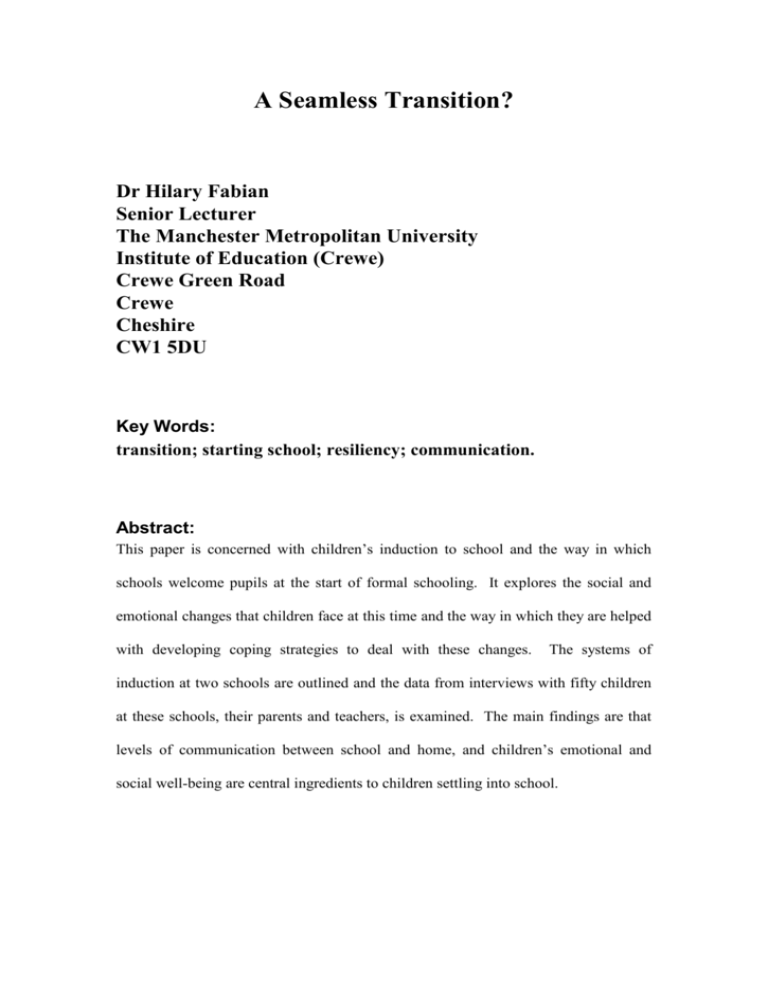A Seamless Transition
advertisement

A Seamless Transition? Dr Hilary Fabian Senior Lecturer The Manchester Metropolitan University Institute of Education (Crewe) Crewe Green Road Crewe Cheshire CW1 5DU Key Words: transition; starting school; resiliency; communication. Abstract: This paper is concerned with children’s induction to school and the way in which schools welcome pupils at the start of formal schooling. It explores the social and emotional changes that children face at this time and the way in which they are helped with developing coping strategies to deal with these changes. The systems of induction at two schools are outlined and the data from interviews with fifty children at these schools, their parents and teachers, is examined. The main findings are that levels of communication between school and home, and children’s emotional and social well-being are central ingredients to children settling into school. Starting school is a major step in a child’s life. For some it is a natural and seamless progression, for others a major upheaval. Regardless of the process, this change involves children coping with a reorganisation of their identity and status as they move from pre-school child to school child. Fthenakis (1998, p.11) maintains that substantial change such as this can “induce psychological changes”. The issue for children is how they will cope with changes and discontinuities as they start school and how they might gain strategies for dealing with such changes. Starting school in the UK is taking place at an increasingly younger age and making “a range of potentially stressful demands” (Ghaye and Pascal 1988, p.3) on practitioners, pupils and their parents. The issue for schools, therefore, is identifying the prime purpose of their pre-entry visits and examining the adequacy of their induction systems. Schools employ a variety of systems for induction which might include a combination of single visits; a series of half day visits; talks to parents either in an afternoon or evening; parents staying with their child; parents leaving their child with the teacher; and experience of lunch time and the playground. On the first day children might start with the rest of the school, have a staggered start before or after other children have begun on the first day or start over a number of days. Many children will have experienced school vicariously through older siblings. However, it might be the size of the establishment or the people with whom they start, rather than the complexity of the induction system that is the key factor in helping children (and their parents) to start school. This paper is based on research that explored the experience of starting school for fifty children in two schools in an area where the children are mainly white, middle class, and with English as their first language. In such conditions it might be assumed that starting school is relatively easy. However, this is not necessarily the case as it can be complex and problematic for any family. The paper examines some of the strategies employed by the two schools to make beginning school a seamless transition for children and their parents. It begins by highlighting some common factors of transition, for it is likely that it is these issues that are central if children are to settle into school easily, and these that schools need to be aware of if they are to help children to develop coping strategies. The Environment Children are sometimes faced with substantial changes in their physical environment at the start of school. Cleave et al (1982, p.39) identified three features of the environment that are critical at this time: “the scale of the child’s setting, the range of his territory, and the limitations on his movements within it.” Physical surroundings can have a significant influence on behaviour. Children coming straight from home may be overwhelmed by the size of the building (Marshall, 1988). Children who have attended playgroups usually do so in small selfcontained buildings used only by children who are close to each other in age (Woolfson, 1993). To help overcome this Barrett found that: “Prior knowledge of the building, organisational patterns, people or activities gave both children and parents more confidence in that they were able to think about, anticipate, and therefore have some control over the new experience.” (Barrett 1986, p.96) Many children will have experienced a range of transitions prior to visiting school, nevertheless it should not be assumed that it will be any easier for those children than for those for whom this is their first transition (Dowling, 1995). Cultural Influences The culture of the school and family will also influence children’s behaviour. Bruner (1996a) suggests that participation in the culture helps in understanding the culture. In this way it is absorbed without conscious thought through ‘osmosis’ (Claxton, 1998). By taking part in the life of the school, children construct their own realities and meanings and adapt them to the system, thereby acquiring the school’s ways of perceiving, thinking, feeling and carrying out discourse. Thus, in a class where children are already established, a new child might watch the behaviour of others in the class to search for clues and learn appropriate behaviour. This is similar to Bruner’s “handover principle” where the child moves from spectator to participant and begins to take responsibility for task performance (Tharp and Gallimore 1998, p.101). However, the group culture cannot be seen “simply as a reified or separate entity” (Neville 1995, p.32), as individuals bring their own culture (which is often rooted in more than one culture) to the group culture and therefore they participate in creating the school culture (Bruner 1996b). This is more likely to happen if there is no established group to join. Individuals pass through several transitional stages in changing status from pre-school to school child. Making friends and becoming part of a group might be helped by attendant rites of passage, the function of which is to “enable the individual to pass from one defined position to another which is equally well defined.” (van Gennep 1960, p.3) Van Gennep proposes that a complete scheme of rites of passage would theoretically include rites of separation, rites of transition, and rites of incorporation. For children starting school these might include buying and trying on the school uniform, entering the school building for the first time, the first meeting with the teacher and first separation from their parent(s). Social and Emotional Experiences It is unlikely that all children will respond to school in the same way, for there are few life transitions that make the same impact on everyone and there is substantial variability in people’s susceptibility to the effects of major social experiences (Rutter and Rutter, 1992). It may, therefore, be that the way in which children are introduced to their new environment which is significant. Bronfenbrenner (1979), proposes that the critical link between two settings is the person who establishes the link in the first place. He suggests that the developmental potential of a setting is enhanced if the child’s initial transition into that setting is in the company of one or more people from a previous setting. For example, if the child’s mother accompanies the child on any preliminary visit, she might serve as a source of security, provide a role model of social interaction and be of significance for the way in which the child is able to function in the new setting. This would also suggest that starting school with a friend is likely to give further confidence. Children’s early social experiences are important to an individual’s development and show promise as motivational contexts for learning (Deegan, 1996). However, Pollard (1996) alleges that building relationships with other children is a major challenge when children begin to make their way outside the home. Winterhoff (1997) puts forward that it is the organisation and structuring of the social setting for children that helps to promote friendships. Certain styles of teacher behaviour have been found to be related to increased pupil learning (Rogers, 1983), therefore the teacher’s attitude plays an important part not only in introducing pupils to each other but to their new setting and in establishing routines and classroom ethos. “Schools that “really trust” their students -schools that value, respect, and know their students- are schools that foster resiliency for their students. Such schools are full of adults who believe that all students are capable of learning the habits of mind to use their minds and hearts well. These adults understand how important it is for student learning and for student hopefulness that all students know that they are cared about, that expectations are high, that purposeful support is in place, and that their participation is valued.” (Krovetz 1999, p.144) Coping with Change No matter when or at what age children begin school, parents and teachers want children to have a start that is going to help them to settle quickly both socially and emotionally and to continue learning. Children need to feel secure and emotionally ready for school to meet new challenges with confidence (Goleman, 1996). Laevers et al (1997, p.15) describe children with high levels of well-being as feeling “like fish in water” in their educational environments with the ability to maximise their learning potential. To achieve this “all-round functioning state” each individual’s basic needs must be satisfied. Laevers et al (1997), propose that these are physical needs; the need for affection, warmth and tenderness; the need for safety, clarity and continuity; the need for recognition; the need to experience oneself as competent; and the need for morality and to give life meaning. Many people enjoy change and adapt easily to transitions, but results of research by Fthenakis and Textor (1998), indicate that there is a need to teach children to cope with transitions by teaching competencies of resilience. Resilience starts with the development of key personal qualities. “Although many parents think that success in joining the infant class depends heavily on a child’s ability to learn, evidence suggests that personal, rather than intellectual, characteristics have the biggest influence on her chance of having a good start to school.” (Woolfson 1999, p.14) Goleman (1998, p229) suggests that helping people to develop skills of rapport, empathy, persuasion, co-operation and consensus-building fosters this good start and the ability to succeed. METHODOLOGY To gain perceptions about the process of children’s (and their parents’) induction to school I interviewed fifty children, their parents and teachers from two schools. There were four main reasons for choosing these particular schools: both schools had three intakes a year; they had a similar number on roll and therefore had similar size buildings and numbers of staff; one was a primary school in a large village and one an infant school on the outskirts of a town. Although of similar size the intake sizes were different in that the village school had small cohorts of children which might create comparisons of effect of intake size; one had a well-established system of induction which the headteacher wanted to appraise, while the other had a new induction co-ordinator who wanted to develop a system of induction that would help the children to cope with the changes that they faced on starting school. Therefore both schools were focusing on their induction strategies. Equal numbers of boys and girls were chosen, half with families new to school and half with a child or children already at school. The children were admitted to the schools in the term before their fifth birthday, thus there were three intakes a year. Of the six groups starting school, three combined with existing classes and two formed classes of new children starting at the same time and one a class where a few children joined them who had started school the previous term. The research began just before the children started their induction programme in the term before they entered fulltime schooling. The First Meeting The teacher is an important element in starting school. Children and parents wanted to meet and know their teacher at an early stage in the induction process. If the teacher lived locally this was seen by parents as a bonus. Children were confused if the person who had worked with them during pre-entry visits was not their teacher at the start of school, as was the case in the town school. Parents considered the personality and experience of the first teacher as significant factors in whether or not their child would learn at school. Those parents who had had one or more children start at school were more confident even if they did not know the teacher who would be teaching their child who was starting this time. Communication and Information The nature of the initial meeting is important. Due to the size of the cohort, the first meeting in the town school was formal and parents were seen as a single group rather than treated as individuals. Smaller cohorts such as those at the village school, encouraged an atmosphere where parents and children felt welcomed, and, as a result, gained confidence in the system. In a small group, parents and children could get to know one another, their teacher and their learning environment easily. This suggests that making the first contact with parents and children in an informal way is more likely to enable a more mutual working relationship. Parents wanted to know about school and its systems. However, when information was substantial, given very rapidly or the terminology used was unfamiliar, then this was confusing and hindered the induction process. Information, given during induction visits that was accessible both in quality and quantity helped parents in their understanding, gave them confidence and reduced stress. Where insufficient information was given it led to parents’ emotional disharmony and, in turn, affected their child’s ability to ‘settle’. anxiety. Misunderstanding or misinformation also caused The induction to school is likely to be improved, therefore, by the appropriate quantity and content of information flow to parents and their children. For those parents who have had one child or more go through the process of starting school it was more straightforward as they had a greater knowledge and understanding of the induction system itself and school generally. Many parents wanted school to be a shared enterprise and viewed induction as a twoway flow of information. Parents have a vast knowledge and understanding about their child and wanted to share it with the teacher in a way that was easy for them and gave relevant information. They felt that completing pre-entry booklets about colour and shape with their child was testing them rather than helping the teacher find out about their child’s achievement. If children are to benefit fully, a working knowledge of the child is advisable for the teacher. If teachers are to build on this, then working in partnership with parents, getting to know each family and viewing parents as supporters of learning, might give continuity to children’s education. Making Friends Those children who started school with a friend were happier than those who were separated from their friends or who did not have a close friend. Some children had made firm friends at pre-school with children of the same year group only to be separated from them at the start of school because of the termly intake system. In the town school some friends were inadvertently parted on admission in September and January because they entered different classes. These children also began school in a mixed-age class where they joined a group of established pupils who have been at school for a term or more. Many of the January intake at both schools found it difficult to settle at the beginning of term as they were joining a class of children where there were existing friendship groups. It caused disruption for both the new children and those who were already established. Many pupils who had started school the term before, were discontented when the new group of children joined their class as they found time and attention was given to the new children and, as a result, less to them. It was not only disrupting for the children but the teacher was having to consider a wide range of developmental needs. During the pre-entry visits at the village school, children found the classroom crowded and confusing. One teacher said “the older ones felt put out by these younger ones impinging on their territory”. Those children who started at the town school in the summer did so with children of a similar age and in a class without older pupils. They found it easier to cope, although they had no role models to follow. They became a cohesive group and were able to establish their own classroom culture. Teachers used systems such as circle time for introducing pupils to their peers, and registration to help them to know each others’ names. A photograph or an object from home acted as an emotional support for some children. Teachers helped pupils to make sense of activities by telling them “this is how we do things in school”, by explaining what was going to happen and by drawing attention to expected behaviour by saying “look at so and so she’s . . . .” Teachers said that pupils also learned about school by “picking it up from the existing children”. They viewed older pupils as a resource and deliberately partnered new children with established members of the class to help them learn the systems, give them emotional support and gain knowledge of routines. They thought that this was particularly helpful at playtime. However, if established pupils are initiating younger ones into the culture of the classroom this might mean that the culture of the new children is not taken into account. Children said they learned about school through listening to the teacher, asking their friends and watching others. However, children may misinterpret what they see and confusion may result as a consequence. CONCLUSION In conclusion let us return to the issues raised at the outset. The first concerned the way in which children cope with changes as they begin school. Here we see that there are certain factors that support children: knowing who their teaching is going to be at an early stage; becoming familiar with the environment in small, informal groups; making the transition with a friend; learning behaviours and systems by watching others; talking with those who have experienced a similar transition; parents and teachers helping children to make friends. It appears from the evidence that it is likely that anxiety is reduced during transitions if levels of social and emotional well-being are high. Entering a mixed aged, established class can be difficult, but the social organisation of a mixed aged group is effective in helping children to make sense of the culture of the class and understand what to do, thereby functioning better as learners. Children’s emotional and social well-being is enhanced if they begin school with a friend or know someone who is already at school who has gone through the induction process. This conclusion is, perhaps, unsurprising, given the importance of sociocultural influences on learning. However, it raises questions about those children who live in isolated areas who have few friends of their own age. This has implications for the way in which schools help parents prepare their children for school by helping their children develop supportive friendships. Children need emotional orientation and confidence to make friends. The more confident a child feels, the higher their self-esteem and the more likely they are to deal with new situations, to experiment and explore and to interact with others and to meet the challenge of the transition. The ability to handle feelings therefore, may be more significant than other factors in the long term as these might help children achieve more quickly and more successfully. This building of self-help strategies and resiliency has increasing importance for young citizens in a fast changing world where they are challenged by frequent changes. Teachers want the induction to school to be pleasant and to ease children into school as quickly as possible, creating a seamless web between settings and thus reducing emotional disharmony. The role of the Reception class teacher in the induction to school therefore, needs to be clearly defined. Where children visit their class during pre-entry visits, high quality experiences in a calm atmosphere with opportunities to see what school is about are more likely to be successful than overcrowded visits where the teacher feels flustered. Smaller structures might enable teachers to get to know the children as individuals and respond to the circumstances and specific needs of each child. The second issue concerned the adequacy of the induction. Here the results are clear. To support children at the start of school, the communication between school and home is vital. Some systems might be misguiding or unhelpful for parents if the flow and level of information is too much, too little or inappropriate. The quality and quantity of communication is critical to harmony during the induction but certain social processes help. These include: ensuring that the information about the induction process itself and the practical details that might be encountered, are given to parents to help them prepare both themselves and their child; giving information in a way that is accessible to parents; teachers learning about children from parents in a way that is straightforward for parents; having structures that allow parents and pupils to ask questions to clarify their understanding of school. It is likely that parents will develop confidence and trust in the school if information is shared and they feel that there is concern for their child. This paper views induction to school not as a one-way process but a more complex interpretation where children and their parents are welcomed and are involved in learning from each other. Schools therefore, might consider the following when developing and evaluating their induction policy: the level of communication with parents; systems for accessing information; children’s friendship groups; and accessible ways of gaining information about children from the parents. This is not to suggest that there is only one system of induction for it might be different for each school, and rather than one common way, might take a variety of forms in practice. BIBLIOGRAPHY Barrett, G. (1986) Starting School: An Evaluation of the Experience. London: Assistant Masters and Mistresses Association. Bronfenbrenner, U. (1979) The Ecology of Human Development: Experiments by Nature and Design. Massachusetts: Harvard University Press. Bruner, J. S. (1996a) The Culture of Education. Massachusetts: Harvard University Press. Bruner, J. S. (1996b) “What we have Learned about Early Learning” in European Early Childhood Education Research Journal. Volume 4. Number 1. pp.5-16. Claxton, G. (1998) Hare Brain Tortoise Mind. London: Fourth Estate Limited. Cleave, S., Jowett, S. and Bate, M. (1982) . . . And So To School: A Study of Continuity from Pre-school to Infant School. Berkshire: NFER-Nelson. Deegan, J. G. (1996) Children’s Friendships in Culturally Diverse Classrooms. London: Falmer Press. Dowling, M. (1995) Starting School at Four: A Joint Endeavour. London: Paul Chapman Publishing. Fthenakis, W. E. (1998) “Family Transitions and Quality in Early Childhood Education” in European Early Childhood Education Research Journal. Volume 6. Number 1. pp.5-17. Fthenakis, W. E. and Textor, M. R. (1998) Qualitat von Kinderbetreuung: deutsche und internationale Perspektiven. Weinheim und Basel: Beltz in Fthenakis, W. E. (1998) “Family Transitions and Quality in Early Childhood Education” in European Early Childhood Education Research Journal. Volume 6. Number 1. pp.5-17. Ghaye, A. and Pascal, C. (1988) Four Year Old Children in Reception Classrooms: Participant Perceptions and Practice. Worcester College of Higher Education. Goleman, D. (1996) Emotional Intelligence. London: Bloomsbury Publishing. Goleman, D. (1998) Working with Emotional Intelligence. London: Bloomsbury. Krovetz, M. L. (1999) Fostering Resiliency. California: Corwin Press. Laevers, F., Vandenbussche, Kog, M. and Depondt, L. (1997) A Process-oriented Child Monitoring System for Young Children. Centre for Experiential Education: Katholieke Universiteit Leuven. Marshall, P. (1988) Transition and Continuity in the Educational Process. London: Kogan Page. Neville, M. (1995) “Social Culture and Effectiveness in an Asian Pluralistic Society” in International Studies in Educational Administration. Volume 23. Number 2. pp.28-37. Pollard, A. (1996) The Social World of Children’s Learning. London: Cassell. Rogers, C. (1983) Freedom to Learn for the Eighties. USA: McMillan Merrill. Rutter, M. and Rutter, M. (1992) Developing Minds: Challenge and Continuity Across the Life Span. London: Penguin. Tharp, R. and Gallimore, R. (1998) “A Theory of Teaching as Assisted Performance” in D. Faulkner, K. Littleton and M. Woodhead (Eds.) Learning Relationships in the Classroom. London: Routledge in association with the Open University. Van Gennep, A. (1960) Rites of Passage. (Translation by Vizedom, M. B. and Caffee, G. L.) London: Routledge and Kegan Paul. Winterhoff, P. A. (1997) “Sociocultural Promotions Constraining Children’s Social Activity: Comparisons and Variability in the Development of Friendships” in J. Tudge, M. J. Shanahan and J. Valsiner (Eds.) Comparisons in Human Development: Understanding Time and Context. Cambridge: Cambridge University Press. Woolfson, R. (1993) “From Nursery to Infant Class” in Nursery World. Volume 93. Number 3369. pp.12-13. Woolfson, R. (1999) Nursery World Volume 99. Number 3662. pp.14-15.





